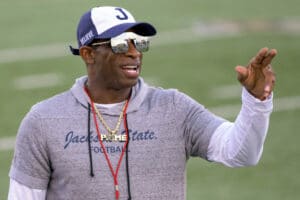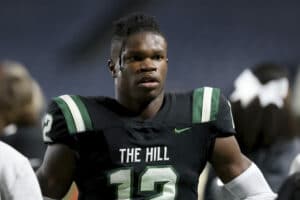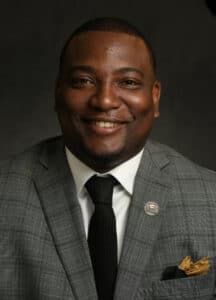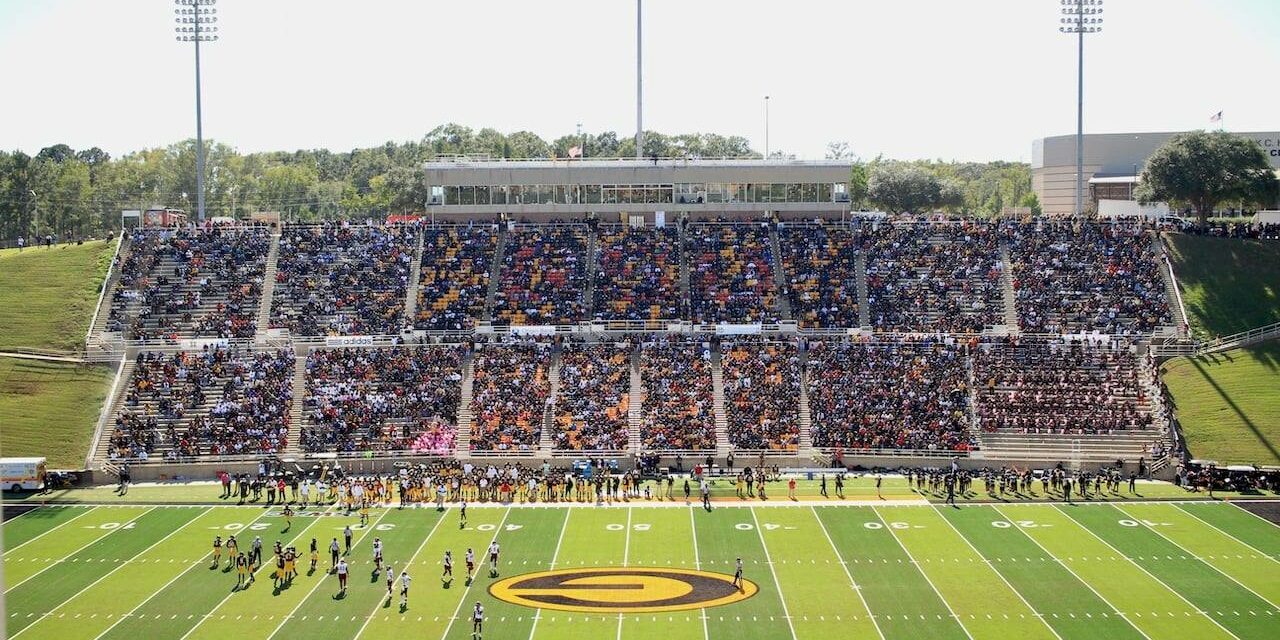With “Neon” Deion Sanders, the nation’s top recruit & NIL laws, the field of HBCU play is changing
Deion Sanders taking the head football coaching job at HBCU Jackson State University in Mississippi and then the following season landing the nation’s top recruit in Travis Hunter, who initially committed to the ACC’s Florida State University, may not have been a seismic event on the lines of an integrated USC beating an all-white Alabama in Tuscaloosa back in 1970, but the rumbling was felt throughout college sports.

Jackson State head coach Deion Sanders (AP Photo/Matthew Hinton)
The Trojans, led by running back Sam “Bam” Cunningham, were the first fully integrated team to play in Alabama, and the drubbing administered to the Crimson Tide — all six USC touchdowns were scored by Black athletes — prompted the team’s legendary coach Paul “Bear” Bryant and other schools across the South to hasten racial desegregation of the game.
See Also: HBCU Bands ‘March’ Into The Spotlight With New Docu-series
Along with what’s happening in Jackson, which has since drawn other top national recruits, there are other examples of the ascendancy of the nation’s Historically Black College and Universities, both in athletics and beyond.
The Washington Post, after analyzing admissions and enrollment data from HBCUs, reported earlier this month that during the past two years of pandemic disruption, attendance held steady or increased at a significant number of the schools, as compared to 2019.
Challenges remain formidable when it comes to the missions of HBCUs, many of which were established to counter segregation in the South that shut them out of mainstream state universities. A recent report published by Forbes estimated that HBCUs have been underfunded to the tune of at least $12.8 billion over the last 30 years compared to mainstream state universities. The problem of underfunding goes beyond athletics, but exists in an era when big-time college football generates billions in broadcast and other revenue, driving construction of new facilities and upgrades to existing ones.
That generally is not the case at HBCUs, which have still sent to the pro football ranks the likes of the late Steve McNair (Alcorn State University), and to the world of space exploration the likes of the late Ronald McNair (North Carolina A&T; MIT), an astronaut who was the second Black person to fly in space before he died in the Challenger space shuttle disaster. The HBCUs have also nurtured the talents of such luminaries as Supreme Court Justice Thurgood Marshall, Nobel Prize winner Toni Morrison, scholar and NAACP co-founder W.E.B. Du Bois, among many, many others.
In the world of football, the names that have come out of the HBCUs are similarly stunning: Walter Payton (Jackson State), Doug Williams (Grambling State), Art Shell (Maryland State), Michael Strahan (Texas Southern), Shannon Sharpe (Savannah State), Jackie Slater (Jackson State), Richard Dent (Tennessee State), Willie Lanier (Morgan State) and Jerry Rice (Mississippi Valley State).
The list goes on. Eddie Robinson, the late Grambling coach who amassed 408 victories, is rightly revered among college football’s greatest and now, in addition to Sanders at Jackson State, other notables like former Ohio State and Tennessee Titans star Eddie George, now head coach at Tennessee State, and former Cleveland Browns head coach Hue Jackson, now at Grambling, are plying their craft at HBCUs.
Despite the talent that still comes through the ranks of some of the nation’s roughly 100 HBCUs, some of the stadiums in which their gridiron stars make their marks are among the nation’s oldest. Not that age is the only determining factor in a venue’s viability.
Non-HBCU Louisiana State University’s Tiger Stadium opened in 1924, but has undergone expansions and upgrades over the decades, including premium seats.
Grambling State’s 19,600-seat Eddie Robinson Stadium opened in 1983 and underwent $2 million in upgrades in 2017. Prairie View (Texas) A&M University opened its 15,000-seat Panther Stadium at Blackshear Field in 2016, making it among the newest in HBCU athletics, but the estimated cost of $60 million is less than the cost of many Power 5 stadium renovations.
NFL Hall of Famer “Neon” Deion Sanders’ son Shedeur Sanders is QB of the Jackson State Tigers, which plays at 63,500-seat Mississippi Veterans Memorial Stadium, opened in 1950 and expanded in 1981. Over the years, the stadium has served as an alternate home for the University of Mississippi and Mississippi State University, which both financially supported the expansion, and has hosted NFL preseason games.

Collins Hill High School wide receiver Travis Hunter pulled a signing day shocker Wednesday, Dec. 15, 2021, deciding to attend Jackson State and play for coach Deion Sanders after being verbally committed to Florida State for months. (Jason Getz/Atlanta Journal-Constitution via AP)
The stadium was also the site of the Dec. 4, 2021, Southwestern Athletic Conference championship game, now sponsored by Cricket Wireless and aired on ESPN2, between Jackson State and Prairie View (JSU won 27-10).
Is it high time for a wave of new facilities and upgrades at HBCU stadiums and arenas?
Prairie View Athletic Director Dr. Donald Reed, the son and grandson of HBCU graduates (a student athlete at the University of North Texas and earned his doctorate from New Mexico State University), said it’s critical that HBCU student athletes have quality facilities and support services. It’s a matter of garnering as much support as possible from the usual suspects: legislatures, alumni and other donors and corporations.
“We’re very blessed and fortunate to have some outstanding facilities from our football stadium to our basketball arena and we’ve done quite a few enhancements, upgrades over the last five to seven years,” Reed said. “We have the same goals across all of our divisions, to provide a great student experience for our athletes, students, staff, patrons and supporters. It’s just, how do we operationalize it.”
Dr. Trayvean Scott, vice president for intercollegiate athletics at Grambling, a former basketball player at Southern University, said HBCUs have always had a lot to offer, but the clout of Sanders, Jackson, George and others, combined with the social justice movement momentum of the last couple of years has shone a light on the space. That’s good, even if the recent bomb threats against HBCUs reveal what could be called a lingering divide in U.S. race relations.
Scott said there has always been star power in HBCU athletics.

Dr. Trayvean Scott (Courtesy Grambling State University)
“We’ve had stars before,” he said. “You can’t tell me that Eddie Robinson wasn’t a star. You can’t tell me Pete Richardson (former Buffalo Bills player and highly successful coach at Winston-Salem State and Southern) wasn’t a star; Marino Casem wasn’t a star; Jake Gaither wasn’t a star; Doug Williams wasn’t a star. Now, it’s more of a fresher, more urban, new generation if you will. It’s kind of reinvigorated HBCUs and really validated HBCUs, which have the ability to attract the best and brightest coaches.”Reed said HBCUs and their teams are seeing increased media coverage and public attention in recent years, in no small part due to the visibility of coaches like Sanders, George and Jackson.“They are public figures in a variety of arenas,” he said.
Reed said more companies are recognizing the commercial opportunities of associating with HBCUs.
“Companies are becoming more cognizant and diversifying their spend across different opportunity and in the college space, those opportunities are different than just traditional corporate sponsorship for Power Five college football programs,” said Dan Shell, president of OVG College, a division of the company that works with schools on operating facilities and developing revenue streams. “HBCUs offer a great value proposition to companies, so I think there is increased commercial opportunity for HBCUs to capitalize on, not just from sponsorship, but from events.”
Shell points to a new basketball educational and scheduling partnership between the Pac-12 and SWAC conferences as an example of the burgeoning attention being paid to HBCUs.
“I think you will see naming rights (deals) at those schools and conferences, you’ll see more scheduling opportunities for them,” he said. “I think you’ll see a recruiting uptick, which we’re already seeing with a couple of really high-profile athletes. There will be a positive and it’s great for college athletics. It’s more of an opportunity than anywhere else; some are untapped.”
Shell said some leaders in the space, like Gregory Moore, commissioner of the Southern Interscholastic Athletic Association, have driven conference-wide sponsorships in a number of categories from autos (Toyota) to soft drinks (Coca-Cola) to apparel (Nike).
Other companies sponsoring HBCU teams or conferences include Nissan, Aflac, Peloton, Tiffany & Co., Beats By Dre and General Motors, which is the exclusive automotive partner of the SWAC. Florida A&M University got Nike to sweeten its sponsorship deal with the school rather than lose out to rival Adidas.
Last winter FAMU put its longtime athletic apparel sponsor Nike on notice that it was ending its deal with the firm and seeking a more lucrative deal with Adidas. The move forced Nike to come back with a more competitive offer.
In a span of about six months, FAMU athletics went from a 50-50 trade deal with Nike to one where Nike actually invests $1.2 in cash into the program.
“Corporate sponsorships and those kinds of things are being introduced to our conferences and universities,” Reed said. “It also helps us share the storied history, tradition and purpose of HBCUs. It does have a financial impact, but it also has a cultural and societal impact as well.”
Reed and Scott also see a trend toward more top athletes choosing to get their education and showcase their talent at HBCUs, driven in no small part by things like the transfer portal and the NCAA’s allowing them to generate revenue tied to name, image and likeness (NIL).
It’s now possible for a top recruit to arrive on a college campus with six-figure deals already in place. That changes the calculus for most athletes aiming for the Alabamas and Notre Dames of the world to maximize potential eventual opportunities beyond college.
For many college athletes with dreams of cashing in on their talent and effort, the future is now and HBCUs, long a viable path into the NFL, are likely to be even more so in the current compliance environment. Both Reed and Scott called it a leveling of the playing field, and most HBCUs have put together guides for helping athletes navigate the new horizons of NIL opportunity.
LONG HISTORY OF ‘CLASSICS’
Neutral-site games, such as the State Fair Classic at the Cotton Bowl in Dallas or the Florida Blue Classic, named for a Sunshine State healthcare industry sponsor, form another unique aspect of HBCU football.
Each “classic” draws alumni, family, friends who arrive days in advance for reunions and other get-togethers and ancillary activities like fraternity and sorority step shows.
“I would call it the cornerstone or the showcase for not only our teams but our universities,” Reed said. “It’s something we pride ourselves in having as part of the experience.”
Camping World Stadium (formerly the Citrus Bowl) in Orlando hosts the Florida Blue Classic between the Florida A&M Rattlers (of Tallhassee) vs. the Bethune-Cookman (Daytona Beach) Wildcats.
“It’s the nation’s top HBCU rivalry. It’s broadcast on ESPN,” said Allen Johnson, executive director of Orlando Venues, which includes the stadium and Amway Center, home of the NBA Orlando Magic.
He said the estimated $30 million economic impact of the game is driven by visits from out-of-town attendees. The series dates back to 1925 but didn’t become known as the Florida Classic until 1978 and it made its debut at the then Citrus Bowl in 1997, Allen said.
“There is so much that goes on beyond just the game on Saturday. They arrive early in the week, there are events throughout the week, luncheons, receptions, dinners, a diversity job fair, the Florida Blue Battle of the Bands at Amway Center and of course a fan fest,” Johnson said.
Recreational vehicles are allowed on the stadium grounds midweek before the game.
“We have people that have had the same space for 20 years and if we don’t have that space for them, we hear about it because they know who the neighbors are,” Johnson said. “You may be a Bethune fan, or Florida A&M, but they really co-mingle together in what I would call a friendly, respectful rivalry.”
Grambling’s Scott says the neutral site classics are fine parts of the HBCU athletics tradition, and he welcomes expanded interest from corporate America, but he stresses that the colleges must be compensated fairly.
“The amount of foot traffic, the amount of impressions, the amount of interest that’s generated from a lot of these contests are really important not only to the HBCUs who perform in them but in the cities where they are being hosted,” he says.
Scott says he knows the importance of games like the Bayou Classic (between Grambling and Southern) and the Magic City Classic (Alabama State and Alabama A&M). Those events are “synonymous with Black excellence,” he said. The organizations that put them on have done an outstanding job of making the events about the institutions, but HBCUs must be vigilant in not allowing themselves “to be shortchanged for the benefit of a promoter.”
“We’ve got an exciting brand of football,” Scott said. “We’ve always had a good product, we’ve always had a lot to offer. I just think that we’re poised to do some pretty special things and not just in football. I think it’s going to benefit all sports (including expanded Olympic sports) at HBCUs. You’re going to see us come out of this as what I believe is one of the most viable athletic (segments) in all of the land.”







